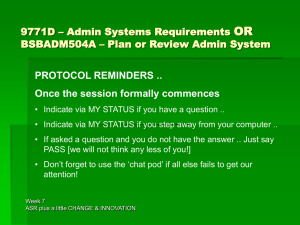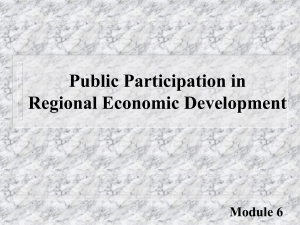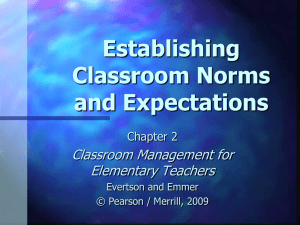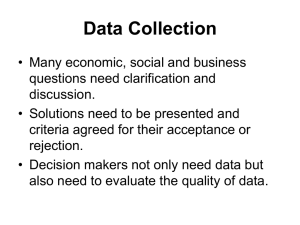WELCOME TO THE COURSE WORK STUDY (IE 341)
advertisement
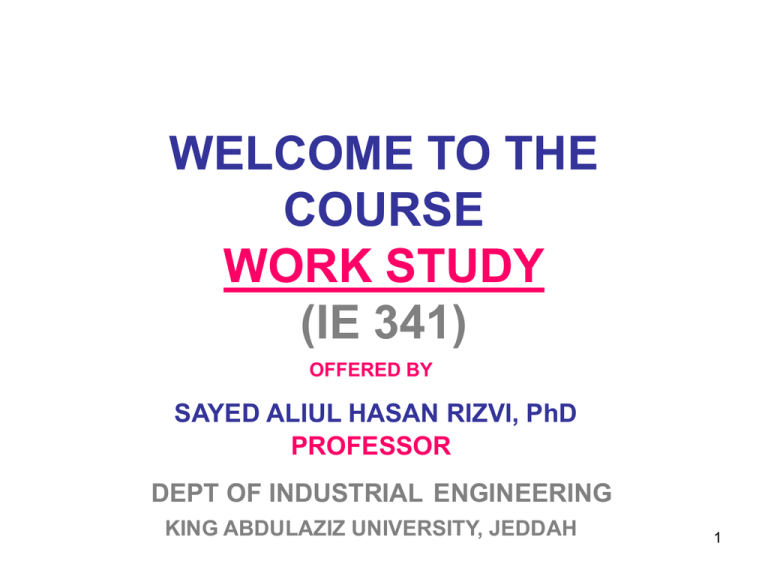
WELCOME TO THE COURSE WORK STUDY (IE 341) OFFERED BY SAYED ALIUL HASAN RIZVI, PhD PROFESSOR DEPT OF INDUSTRIAL ENGINEERING KING ABDULAZIZ UNIVERSITY, JEDDAH 1 INTRODUCTION • • With increasing complexities of the technological world,need to simplify the work system has been increasing day by day. Work study is an area of knowledge that addresses the problem of work simplification with the basic objectives of 1. PRODUCTIVITY ENHANCEMENT, and 2. HUMAN COMFORT & SAFETY 2 “WORK STYDY” HAS MANY OTHER NAMES FOR EXAMPLE METHODS ENGINEERING, WORK SCIENCE, WORK DESIGN, JOB ESIGN WORK METHODS DESIGN &WORK MEASUREMENT MOTION &TIME STUDY Original names were: Motion study,Time Study & then, Motion & Time Study 3 DEFINITION It is the systematic study of work systems with the purposes of 1. Developing the preferred system and Method ( with lowest cost) 2. Standardizing this system and method 3. Determining standard time for the task 4. Assisting in training the worker in the preferred Method 4 EXPLANATION Above stated definition has FOUR parts. However, the TWO most important for WORK STUDY are: 1.MOTION STUDY (or Work Methods Design) & 2. TIME STUDY (or Work Measurement) 5 ILO DEFINITION It is the systematic examination of carrying on activities so as to improve the effective use of resources and to set standards of performance for the activities being carried out. 6 LECTURE : 3-4 CHAPTER : 2 WORK STUDY & PRODUCTIVITY 7 HUMAN’S BASIC NEEDS & PRODUCTIVITY In 1950: world population was 2.5 b Now : it is of the order of 6.5 b 90% increase has occurred in developing nations. 8 CONTD. Out of these people, more than 1 b are below poverty line, struggling for the BASIC NEEDS which are : • food, • clothing, • shelter, • security, • health and • essentials like water, sanitation etc. 9 CONTD. For Improving the STANDARD OF LIVING, of its citizens, the concerned nation must raise its PRODUCTIVITY for economic growth. For any organization, its input-output system can be represented as follows: PROCESS INPUT OUTPUT 10 CONTD. INPUTS may be in the form of different M’s: man, material, machine, method, management, market, message ( i.e. information), moment (i.e. time ) OUTPUT may be a product or service. PRODUCTIVITY may be defined as follows: 11 MATHEMATICALLY: PRODUCTIVITY = [OUTPUT / INPUT] THUS: PRODUCTIVITY measures the extent to which a certain OUTPUT can be extracted FROM A GIVEN INPUT. It may be noted that PRODUCTION ( which is number of products) is different from PRODUCTIVITY. 12 CONTD. • WORK STUDY IS A TOOL OF PRODUCTIVITY ENHANCEMENT. • It simplifies a job TO REDUCE UNNECESSARY OR EXCESS WORK, WASTEFUL USE OF RESOURCES and sets up STANDARD TIME for performing that job. 13 CONTD. THIS IMPLIES THAT : • THERE IS A DIRECT RELATIONSHIP BETWEEN WORK STUDY AND PRODUCTIVITY. • THUS, BY APPLYING WS PRINCIPLES IF THE COST IS REDUCED BY 20%, THEN, WE CAN SAY THAT PRODUCTIVITY HAS GONE UP BY 20%. 14 WORK CONTENT OF A JOB “WORK CONTENT” • It means the amount of work contained in a given job/work/product/process. • It is measured in MAN-HOURS/ WORKHOURS (effort or labor of ONE person for ONE hour), or MACHINE HOURS (running of a machine/plant for ONE hour). 15 TOTAL TIME OF A JOB ‘TOTAL TIME OFA JOB’ COMPRISES OF: 1. BASIC WORK CONTENT & 2. EXCESS WORK CONTENT BASIC WORK CONTENT is irreducible minimum time required theoretically to produce one unit of product In REAL LIFE WORLD, actual operation times are FAR MORE IN EXCESS due to the EXCESS WORK CONTENT. 16 CONTD. • EXCESS WORK CONTENT may be due to following THREE CATEGORIES of factors: (i) A-category: A1: A2: A3: POOR DESIGN & FREQUENT DESIGN CHANGES WASTE OF MATERIALS INAPPROPRIATE QUALITY STANDARDS 17 CONTD. (ii) B-category B1: POOR LAYOUT & POOR UTILISATION OF SPACE B2: INADEQUATE MATERIAL HANDLING B3: FREQUENT STOPPAGES AS PRODUCTION CHANGES FROM ONE PRODUCT TO ANOTHER 18 CONTD. B4: INEFFECTIVE METHOD OF WORK B5: POOR PLANNING OF INVENTORY B6: FREQUENT BREAKDOWN OF MACHINES AND EQUIPMENT 19 iii) C-category C1: ABSENTEEISM AND LATENESS C2: POOR WORKMANSHIP, AND C3: ACCIDENTS AND OCCUPATIONAL HAZARDS TOTAL TIME OF A JOB = BASIC WORK CONTENT + EXCESS WORK CONTENT ( A + B +C ) (OR, TOTAL INEFFECTIVE TIME) 20 LECTURE : 5-8 CHAPTER : 3 WORK STUDY ,THE APPROACH: 21 WS IS VALUABLE because By carrying out its systematic procedures,one can get results as good as or even better than the less systematic genius would have been able to achieve in the past. It is systematic both in the investigation of the problem and in the development of its solution. 22 CONTD. • It raises productivity of the plant /unit by simply reorganization of the work, with either a nominal or no extra input. It sets the performance standards on which the effectiveness of the production planning and control depends. 23 CONTD. It contributes to human safety by providing safer methods of work, and allows for better working conditions by exposing the hazardous situations. Its application starts providing savings immediately, and continues till the operation continues. 24 CONTD. It is a tool that can be used every where, be it industrial or non-industrial environment. It is easy and relatively cheaper in its application. It is an excellent weapon for starting an attack on the inefficient system. • HOWEVER, WS SPECIALISTS SHOULD APPLY IT TACTFULLY, SO THAT WORKERS REMAIN COOPERATIVE WHILE STUDIES ARE CONDUCTED IN THE PLANT. 25 TECHNIQUES OF WORK STUDY: These are: 1. METHOD STUDY is the systematic recording and critical examination of ways of doing things in order to make improvements. THUS it simplifies the job and develops more economical method of doing it. 2.WORK MEASUREMENT is the application of techniques designed to establish the time for a qualified worker to carry out a task at a defined rate of working. THUS it determines how long it should take to carry out the work. 26 BASIC PROCEDURE OF WS comprise of following STEPS: 1.SELECT 2.RECORD the job/task/process to be studied. all the relevant data/facts about the selected job. 3.EXAMINE the recorded facts critically by challenging its purpose, place, sequence, person, and method. 4.DEVELOP new methods,as alternative methods, of doing the selected job. 5.EVALUATE results of different alternative solutions. 6.DEFINE the new method and present it to the concerned people. 7.INSTAL the new method and provide training to the concerned staff . 8.MAINTAIN the new standard practice and establish control procedures. 27 ACCORDING TO BARNES: Since Methods Engineering is a form of CREATIVE PROBLEM SOLVING, THE GENERAL PROBLEM SOLVING PROCESSES can be employed in WS also. Accordingly, following FIVE STEPS can be used: 1.Problem definition : Statement of the purpose/goal 2. Analysis of the problem : Fact-recording no evaluation 3.Search for possible solutions : Finding several alternative solutions. 4. Evaluation of alternatives : Examining which alternative meets the goal/criteria most, in order to evolve the preferred solution. & 5. Recommendation for action : Communicating the details ,related to the preferred method to all concerned. 28 LECTURE : 9-10 CHAPTER : 6 METHOD STUDY & JOB SELECTION 29 STEP I : JOB/TASK/PROCESS SELECTION It involves following considerations: 1. ECONOMIC CONSIDERATIONS 2. TECHNOLOGICAL CONSIDERATIONS and 3. HUMAN CONSIDERATIONS 30 Contd. 1.ECONOMIC CONSIDERATIONS Cost effectiveness i.e. to check whether or not the WS application would pay. For this, key-profit giving/ costliest operations with largest waste/scrap should be attacked first. Next bottleneck operations, repetitive operations, repeated material handling operations should be studied. For locating most important operations, PARETO ANALYSIS could be used. 31 2.TECHNICAL/TECHNOLOGICAL CONSIDERATIONS The analysis involves application of WS for the selection of the operations/processes where new technology e.g. automation/ robotisation should be introduced. 32 3.HUMAN CONSIDERATIONS Analysis involves location of those operations which present the sources of dissatisfaction and/or annoyance to the workers due to fatigue or monotony or unsafe environment or a work which is clumsy in nature. 33 LECTURE : 11-12 CHAPTER : 7 RECORDING THE FACTS : DIAGRAMS & CHARTS 34 STEP II : RECORDING THE FACTS Related to the existing process/ job ALL THE FACTS should be recorded ACCURATELY. TOOLS OF FACT-RECORDING are: (A) CHARTS, which may be of two types: (i) Based on SEQUENCE: (a) Outline Process Chart (b) Flow Process Chart (c) Two-Handed Chart ( or Operation Chart / Left Hand & Right Hand chart) 35 CONTD. (ii ) Based on TIME scale: (a) Multiple Activity Chart (b) SIMO ( SImultaneous MOtion) Chart (B) DIAGRAMS: which may be of the following types: Flow diagram, String Diagram, Travel Chart, Cyclegraph, & Chronocyclegraph, 36 PROCESS CHART SYMBOLS ASME has recommended FIVE standard symbols to be used on Process Charts, given below: 1. OPERATION : Main steps of the task /job involving modification /change. 2. INSPECTION: Checking quality / quantity. TRANSPORTATION : For movement of persons/materials. 4. DELAY (TEMPORARY) : For waiting time of operators or materials. 5. STORAGE (PERMANENT DELAY)] : For controlled storage involving authorized issue/receipt of material etc. NOTE: FOR TWO PARALLEL EVENTS, BOTH ARE 3. SHOWN IN ONE JOINT OR COMBINED SYMBOL: e. g. operation & inspection ,jointly are shown by symbol, indicated in the figure. 37 THE OUTLINE FLOW PROCESS CHART • It uses ONLY TWO SYMBOLS: & • It provides an OVERALL PICTURE of the process / job / task. • Primarily it is used to show the sequence of operations & inspections for a MANUFACTURING or an ASSEMBLY kind of jobs. 38 FLOW PROCESSCHART • It uses ALL THE FIVE SYMBOLS and provides the total sum details of the process/job under study. • A Flow Process chart may be of the following types: 1.MAN-TYPE in which every symbol is related to his/her activity only. 2.MATERIAL TYPE in which every symbol is related to the material of the job or a document (e.g. in offices) or a machine/equipment. • Data / information in a flow process chart are recorded in specifically designed FORM, as given 39 in the TEXT BOOK / CLASS ROOM. LECTURE : 13-14 CHAPTER : 7 (CONTD) 40 STEP III : CRITICAL EXAMINATION The facts recorded in the Flow Process Chart are now EXAMINED CRITICALLY by applying the QUESTIONING TECHNIQUE, which involves the following SEQUENCE: 41 CONTD. • • • • • PURPOSE for which the activity is done PLACE at ,, ,, ,, ,, ,, SEQUENCE in ,, ,, ,, ,, ,, PERSON by whom ,, ,, ,, ,, ,, MEANS by which ,, ,, ,, ,, ,, WITH THE OBJECTIVE OF ELIMINATING/ COMBINING/ REARRANGING/ SIMPLIFYING THE ACTIVITIES INVOLVED IN THE PROCESS. QUESTIONING TECHNIQUE involves 1. PRIMARY QUESTIONS and 42 2. SECONDARY QUESTIONS explained below: PRIMARY QUESTIONS According to the QUESTIONING TECHNIQUE the PRIMARY QUESTIONS are as follows: • Purpose-based: WHAT is actually done? WHY is the activity necessary, at all? • Place-based: WHERE is it being done? WHY at this place? • Sequence-based: WHEN is it done? WHY at that time? • Person-based: • Means-based: WHO is doing it ? WHY by this person? HOW is it being done? WHY in that particular way? ELIMINATE COMBINE or REARRANGE SIMPLIFY 43 SECONDARY QUESTIONS • Corresponding to each answer obtained through the PRIMARY QUESTIONS further questions are raised to explore about the ALTERNATIVES i. e. alternate purpose, place, sequence, person & means. This methodology makes use of the SECONDARY QUESTIONS given as follows: 44 Contd. • • • • • WHAT ELSE might be done? WHERE ELSE might it be done? WHEN ELSE might it be done? WHO ELSE might do it? & HOW ELSE might it be done? BY ANSWERING THE PRIMARY & SECONDARY QUESTIONS WE USE THE SYSTEMATIC CRITICAL EXAMINATION IN ORDER TO EVOLVE A BETTER METHOD OF 45 DOING THE WORK. Contd. AS A RESULT, ONE CAN DEVELOP A BETTER METHOD IN LIGHT OF THE OBTAINED ANSWERS TO THE FOLLOWING QUESTIONS: • • • • • WHAT should be done? WHERE should it be done? WHEN should it be done? WHO should do it ? HOW should it be done? 46 LECTURE : 15-17 CHAPTER : 8 RECORDING MOVEMENT OF WORKERS/MATERIALS 47 RECORDINGMOVEMENT OF WORKERS/ MATERIALS TOOLS USED FOR THIS PURPOSE ARE: • STRING DIAGRAM • FLOW DIAGRAM • TRAVEL CHART 48 STRING DIAGRAM • IT IS A SCALE PLAN OR MODEL ON WHICH A THREAD OR STRING IS USED TO TRACE AND MEASURE THE PATH OF WORKERS/ MATERIALS DURING A SPECIFIED SEQUENCE OF EVENTS. • LENGTH OF THE THREAD/STRING MEASURES THE DISTANCE MOVED. 49 FLOW DIAGRAM • It is a FLOOR-PLAN showing the path of travel of the operator or the material, through the plant. • It ALSO indicates the direction of travel by means of arrows, drawn on the diagram. 50 TRAVEL CHART ( or, FROM-TO CHART) • It is a tabular record of quantitative data about movement of workers/materials/equipment between any number of places over a given period of time. It is always in the form of a SQUIRE, having within it the squires. EACH SMALL SQUIRE REPRESENTS A STATION. Along the TOP, squires from left to right represent the stations FROM where movement or travel occurs. Along those DOWN THE LEFT HAND, the squires represent the stations TO which the movement is made. 51 MAN-MACHINE CHART (MULTIPLE ACTIVITY CHART) • This kind of process chart records the activities of the operator as well as the machine on the same chart against a common time scale. • Separate vertical columns ( in the form of bars) are used for both. • The chart clearly indicates the IDLENESS (or UTILISATION) of operator as well as the machine. • On the basis of the recorded events in the chart, one can rearrange the process so that IDLE-TIME is reduced, or BETTER UTILISATION of the operator/machine is achieved. • It is used for balancing the work between man and machine ;proper utilization of maintenance crew /team-activities in mass production. 52 LECTURE : 18-24 CHAPTER : 9 METHODS & MOVEMENTS AT THE WORKPLACE 53 METHODS & MOVEMENTS AT THE WORKPLACE PRINCIPLES OF MOTION ECONOMY These principles can be helpful in work design, in reducing the human fatigue and in improving the work efficiency. According to Barnes, these can be presented under following THREE subgroups: 1.Principles of motion economy as related to the USE OF HUMAN BODY 2.Principles of motion economy as related to the ARRANGEMENT OF THE WORKPLACE 3.Principles of motion economy as related to the DESIGN OF TOOLS & EQUIPMENT 54 [A] .Principles of motion economy as related to the USE OF HUMAN BODY • 1.The two hands should begin and complete their movements at the same time. • 2. The two hands should not be idle at the same time. • 3.Motions of the arms should be symmetrical and in opposite direction and should be made simultaneously. 55 Principles: Contd • 4.Hand and body motions should be made at the lowest classification at which it is possible to do the work satisfactorily. [The term ‘CLASSIFICATION OF HAND MOTION’ is explained as follows] 56 CLASSIFICATION OF HAND MOTIONS CLASS PIVOT BODY MEMBERS MOVED 1 2 3 4 5 Knuckle Wrist Elbow Shoulder Trunk Finger (F) Hand (H) + F Fore Arm (FA) + H + F Upper Arm (UA) +FA+H+F Torso + UA + FA + H + F 57 Principles : CONTD. • 5. Momentum should be employed to help the worker ,but should be reduced to a minimum whenever it is to overcome by muscular effort. • 6.Continuous curved motions are to be preferred to straight line motion involving sudden and sharp changes in direction. • 7. Ballistic (free-swinging) motions are faster, easier, and more accurate than restricted or controlled motions. 58 . Principles CONTD • 8.Rhythm is essential to the smooth and automatic performance of a repetitive operation. The work should be arranged to permit an easy and natural rhythm whenever it is possible. • 9.Work should be arranged so that eyemovements are confined to a comfortable area, without the need for frequent changes of the focus. 59 [B].Principles of motion economy as related to the ARRANGEMENT OF THE WORKPLACE • 1.Definite and fixed positions/stations should be provided for all tools and materials to permit habit formation. • 2.Tools and materials should be prepositioned to reduce searching. 60 CONTD. • 3.Gravity-feed, bins and containers should be used to deliver the materials as close to the point of use as possible. • 4.Tools, materials, and controls should be located within the ‘maximum working area’ and as near to the worker as possible. [WORKING AREA (WA) may be divided into: 1.NORMAL WA & 2.MAXIMUM WA explained below61 ] Normal Working Area (WA) : ( Finger + wrist + elbow) Cotd. Movement MOST CONVENIENT ZONE Edge of bench operator operator Maximum WA : (Shoulder Movement) 62 DIMENSIONS FOR SEATED TASKS • 1.SEAT HEIGHT should be adjustable : ( range:36-45 ) • 2. WORK SURFACE HEIGHT should be around elbow level (range:65-72 cm) • 3.LEG CLEARANCE : 40 cm at knee level & 60 cm for the feet • 4.THIGH CLEARANCE : 20 cm minimum • 5.WORK SURFACE THICKNESS : 5cm max. 63 Principles : CONTD. • 5.Materials and tools should be arranged to permit the best sequence of motions. • 6.‘Drop deliveries’ or ejectors should be used wherever possible, so that operators do not have to use his/her hands to dispose of the finished work. 64 Principles : CONTD. • 7.Provision should be made for adequate lighting and, a chair of the type of height to permit good posture should be provided. The height of the workplace and seat should be arranged to allow alternate standing and sitting. • 8.The color of the workplace should contrast with that of the work and thus reduce the eye-fatigue. 65 [C]. Principles of motion economy as related to the the DESIGN OF TOOLS & EQUIPMENT • 1.The hands should be relieved of all work of “holding” the work-piece where this can be done by a jig, fixture or foot-operated device. • 2.Two or more tools should be combined wherever possible. • 3.Where each finger performs some specific movement, as in typewriting, the load should be distributed in accordance with the inherent capacities of the fingers. 66 Principles : CONTD. • 4.Handles such as those on cranks and large screw divers should be so designed that as much surface of the hand as possible can come in contact with the handle. This is specially necessary when considerable force has to be used on the handle. • 5.Levers crossbars and hand-wheels should be so placed that the operator can use them with the least change in body position and the largest mechanical advantage. 67 TWO-HANDED PROCESS CHART (OPERATION CHART/LEFT-HAND RIGHT-HAND CHART) • It shows the activities of the two hands in relation to one another. ACCORDING TO BARNES: • It uses ONLY TWO SYMBOLS: & Small circle for TRANSPORTATION & Big circle for OPERATION. ACCORDING TO ILO : • It uses ALL process chart symbols EXCEPT INSPECTION • After studying a few cycles recording is done. • ONLY ONE HAND is charted AT A TIME. 68 FUNDAMENTAL HAND MOTIONS • Gilbreth observed that most work done by two hands consists of a few fundamental motions. • He called EACH ONE of them as THERBLIG. (name of GILBRETH ,read in reverse order). THERBLIG : GILBRETH ( read in reverse order) 69 contd. • Today we have 17 Therbligs as follows: Search, select, grasp, transport empty, transport loaded, hold, release load position, preposition, inspect, assemble, disassemble, use, unavoidable delay avoidable delay, plan, & rest for overcoming fatigue. • THESE ARE USED IN MICROMOTION STUDIES (FACTS RECORDED ON FILMS) 70 MICROMOTION STUDIES • Operations with very short cycles & repetitive cycles need greater details to analyze it for saving motions and effort( i.e. planning for lesser fatigue). This goal can be achieved through Micro-motion Studies. • MICRO means ‘small. Thus here we study the motions in terms of THERBLIGS. 71 CONTD. • Such a study involves the use of FILM and VIDEO when operator performs the job. • Later on the film/video can be run slowly THROUGH A PROJECTOR and • ‘Frame by frame’ analysis of the work can be carried out. • Film provides greater flexibility of filming and playback speeds WHEREAS video is easier in use. 72 Contd. STEPS: 1. Filming the job 2. Analysis of the film, & 3. Presenting DATA/FACTS graphically through SIMO chart. (SImultaneous Motion Chart) 73 CONTD. • EQUIPMENT: Camera, Film, Micro-chronometer, Exposure meter, Flood lights, Reflectors, Tripod,, Projector etc. OR, VIDEOCAMERA plus its accessories for filming operation. 74 CONTD. ADVANTAGES OF MICROMOTION STUDIES OVER DIRECT OBSERVATION. • • • • • Greater details are made availalble More accurate Easier in data collection Better for record keeping Help in work study personnel's development 75 FILM ANALYSIS: • Film is run on projector, • Details of the work-cycle are identified in terms of THERBLIGS, first for Left hand and then for Right hand, • TIME ( in WINK) is noted from the Chronometer readings of the film for each therblig. [1 WINK = (1/2000) OF A MINUTE ]76 CONTD. With these data SIMO (Simultaneous Motion) chart is made as shown below : LH Activities Therblig Time Therblig RH Activity 77 MEMOMOTION ANALYSIS • It was introduced by MUNDEL. • It is a special type of micro-motion study in which activities are FILMED AT MUCH SLOWER SPEED (60 to 100 frames per minute) i.e. at longer intervals than normal (intervals being between 0.5 to 4 s). • Thus a general pattern of movements can be obtained and avoidable motions can be identified. 78 contd. • STEPS: Study the operation to be filmed ; Prepare the film ; Analyze the film ; Develop a better method. • ADVANTAGES: More economical (less film consumed) and Long sequence of activities can be recorded; • APPLICATIONS: Team-work studies ; Material flow studies ( e.g. baggage movement at the airports ) Long cycle job studies & 79 Study of artificial limbs’ motions etc CYCLEGRAPH • It was introduced by Gilbreth. • It is a photographic record of the path of movement of the operator doing a job. • Little source of light (bulb) is attached to the hand or finger or any other body part, whose motions are to be analyzed. When he/she performs the operation and photograph is taken continuously, the path of motions is recorded on the film as CONTINUOUS STREAK OF LIGHT as shown below OPERATO R 80 CHRONOCYCLEGRAPH • It is a special type of cycle-graph in which the light source (bulb) is suitably INTERRUPTED ELECTRICALLY so that the path of motion in the photograph appears as a SERIES OF PEAR-SHAPED SPOTS instead of continuous streak of light as shown below PEAR-SHAPED SPOTS MOTION DIRECTION • The pointed end of the pear shows the direction of movement. • More elongated and spaced pear-spots indicate higher speed of operation.. • It helps in studying the complex and restricted motions also. 81


